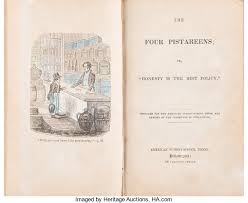American Sunday School Movement
Listen to the Recess! Clip
| Author | Rita Smith |
| Air Date | 5/14/2003 |

American Sunday School Movement Transcript
In May of 1824 in Philadelphia, The American Sunday School Union was established to serve as a clearinghouse for the many Sunday Schools which had sprung up throughout the northeast, and the Ohio Valley. It was an interdenominational society that aimed “to disseminate useful information, to circulate moral and religious publications in every part of the land…to plant a Sunday School wherever there is a population and to open the Bible to all the rising generation without distinction of sect, or creed, or custom.”1
The stories were written by anonymous authors and submitted to the Union Committee on Publication, which edited the content of each book published and distributed it to Sunday School libraries by the Union. They branched out from the Bible and catechism books of earlier libraries and began to include books which dealt with American history and civic values as well as religious values. One of the early books, for example, was a biography of George Washington, which attempted to make the children and youth of America familiar with history and to define the admirable moral and religious traits present in the character of Washington. Other tales gave glimpses of Palestine, the Sandwich Islands and Tahiti, albeit with strong missionary implications. They praised temperance, humility, honesty, obedience, and social and personal duty while denouncing pride, quarreling, neglect of lessons and playing marbles.
These publications have been roundly criticized as doleful little books. Cornelia Meigs complained that the “weight of platitudes and sentimentality was a dead load on the forward progress of new literature of such infinite possibilities.” Alice M. Jordan described them as “overloaded with precocious goodness, morbid piety and sickly sentiment.”2 And although claims were made in advertising that the books were adapted to the capacity of juvenile readers and that even the “weakest learners” would be served, much of the vocabulary, length of sentences, the weighty descriptive passages and general content made that unlikely. But other historians have noted that the [Sunday School] library books played a vital part in the culture of the people, and Harold Rugg felt that “since the communities lacked reading matter, this movement was a means of extending knowledge,”3 and besides actually teaching the young how to read, it did provide many children with a taste for reading which otherwise they would not have acquired.
1 Quoted by Cushman, p. 209.
2 Ibid. p. 229.
3 Ibid. p. 230.
Sources
Cushman, Alice B. “A Nineteenth Century Plan for Reading: The American Sunday School Movement,” Reprinted in The Hewins Lectures 1947- 1962, Siri Andrews, ed. Boston: The Horn Book, Inc., 1963. p. 205-233